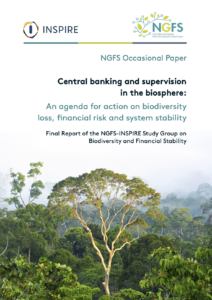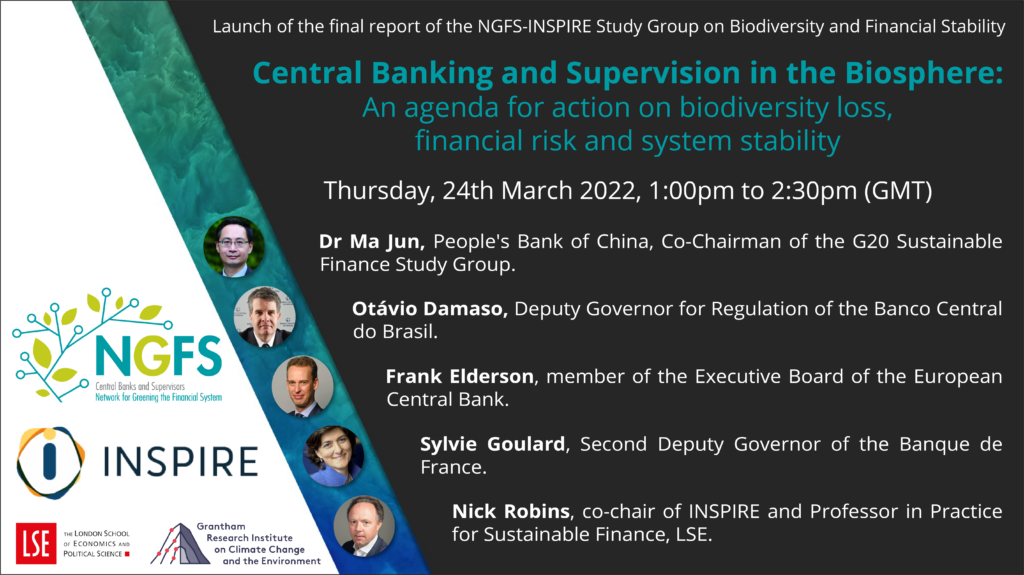
Biodiversity loss poses a significant and under-appreciated threat to financial stability, and central banks and financial supervisors should act to confront nature-related risks, according to a new report published today (24 March 2022) by
a group of central bankers, financial supervisors and academic researchers.
The report argues that biodiversity loss poses systemic risks in the same way as climate change. It calls for a concerted response by central banks and financial supervisors similar to that triggered by warnings on climate risk six years ago from Mark Carney when he was Governor of the Bank of England.
The report on ‘Central banking and supervision in the biosphere: An agenda for action on biodiversity loss, financial risk and system stability’ is co-authored by a special study group set up by the Central Banks and Supervisors’ Network for Greening the Financial System (NGFS) and INSPIRE, an independent research network. The study group consisted of more than 100 central bankers, supervisors and researchers.
The study group was co-chaired by Nick Robins, who is professor in practice for sustainable finance at the Grantham Research Institute on Climate Change and the Environment at the London School of Economics and Political Science, and also co-chair of INSPIRE. He said: “Biodiversity loss is potentially as economically and financially impactful as climate change, but has so far received much less attention. This report shows that these twin threats now need to be tackled in a joined-up way by central banks and supervisors to build a nature-positive financial system.”
The study group was also co-chaired by Ma Jun, who is Chair of the NGFS Workstream on Research and Special Advisor to the Governor of the People’s Bank of China. He said: “International efforts to halt biodiversity loss are intensifying, with agreement expected this year at COP15 in Kunming, China, on a new Global Biodiversity Framework. This report shows that addressing biodiversity-related financial risks clearly falls within the mandates of central banks and supervisors and sets out the role they can play to bring the Framework to life across the financial sector.”
Ravi Menon, Managing Director of the Monetary Authority of Singapore and Chair of the NGFS, said: “Biodiversity loss could have significant macroeconomic implications. Failure to account for, mitigate, and adapt to these implications is a source of risks relevant for financial stability.”
The report argues that economic activity and financial assets depend upon the ecosystem services provided by biodiversity and the environment. This means that there are physical risks to finance if these services are undermined. But the transition to a global economy that protects nature also creates potential risks related to policy, technology, market and reputation. In addition, the financial system has an impact on biodiversity through the economic activities that are enabled by it lending, investment and insurance.
The report provides the first global assessment of why and how central banks and supervisors can respond to rising risks from biodiversity loss. It identifies 45 examples of authorities already taking action in countries such as Brazil, China, France, Malaysia, the Netherlands and the UK. It concludes that these initial first steps now need to be developed into a comprehensive response. To achieve this, the report makes five recommendations:
- Central banks and supervisors should recognise biodiversity loss as a potential source of economic and financial risk and commit to developing a response strategy. Financial authorities could include biodiversity loss within their green finance and environmental strategies, taking an integrated approach which highlights the links with climate change as well as the specific threats that it might pose to financial and price stability.
- Central banks and financial supervisors should build the skills and the capacity to analyse and address these risks. This should cover central bank and supervisory staff as well as market participants and other stakeholders. Emerging and developing economies have particular needs for capacity-building, and there is a rich agenda for further research to strengthen the evidence-base.
- Central banks and financial supervisors need to assess the degree to which financial systems are exposed to biodiversity loss. This could include conducting assessments of financial sector dependency and of impacts on biodiversity, as well as developing biodiversity-related scenario analysis and stress tests, and helping to create a dashboard of biodiversity metrics.
- Central banks and supervisors need to explore options for supervisory actions to manage biodiversity-related risks and minimise negative impacts on ecosystems. This could include the development of supervisory expectations of financial institutions such as banks, insurers and investors in relation to governance, risk management and strategy, disclosure and financial conduct.
- Central banks and financial supervisors can help to build the necessary financial architecture for mobilising investment that helps to conserve biodiversity. This could include contributing to the development of biodiversity taxonomies, exploring options for integrating biodiversity-related considerations into monetary policy, and incorporating biodiversity protection within central bank investment portfolios.
In addition, the report sets out a research agenda for central banks and academic researchers to continue to address some of the analytical and data gaps that the study group identified in the course of its work. Developing scenarios that describe the possible impacts of biodiversity loss, analogous to those developed for climate, is likely to be an area of particular focus.
This report is the final publication from the NGFS-INSPIRE study group, which was set up in 2021.
Explore the Study Group’s findings and recommendations here

